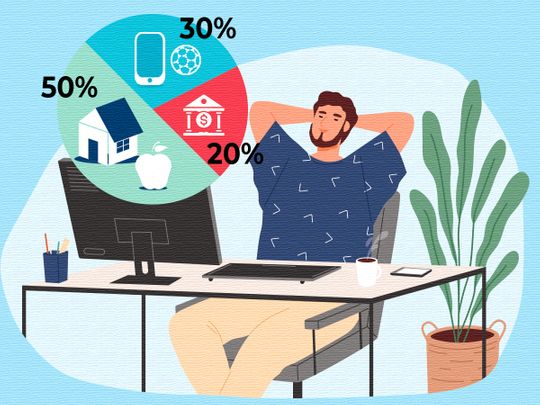Dubai: When budgeting, once you have evaluated how much you spend every month on living expenses, rent, paying off debt and retirement savings, what do you do next?
One rule designed to help you plan and manage your spending is the 50-30-20 rule – which is a popular rule for breaking down your budget, considered as ‘intuitive’ and ‘simple’ among many.
US Senator and Harvard university bankruptcy expert Elizabeth Warren was the first to coin the ‘50-30-20 rule’ for spending and saving with her daughter, in their book ‘All Your Worth: The Ultimate Lifetime Money Plan’.
There are looser variations to this rule, like the 80-20 rule, in which you use 20 per cent of your income for financial goals and spend 80 per cent on everything else, however, financial planners say the 50-30-20 rule has been more widely adopted than others.
How do you apply 50-30-20 rule to your budget?
The first thing you must do is calculate how much money you can allocate to your needs, wants, and savings or debt. Let’s say you’ve calculated your income as Dh6,000 per month. In this case, you’d have Dh3,000 for needs, Dh1,800 for wants, and Dh1,200 for savings and debt.
Now that you know how much you can spend in each category using the 50-30-20 rule budget, the question is which expenses go in each category. With some discretion in determining what fits into each category, here are some general guidelines to follow.
Setting apart 50 per cent of income for ‘needs’
What can be considered as ‘needs’? Needs are expenses that you must keep in your budget no matter what. These include things like housing, utilities, transportation and health care expenses; at least the minimum payments on your debts; and the bare minimum of basic clothing and supplies for living.
Essentially, these are those bills that you absolutely must pay and are the things necessary for survival.
‘Needs’, for most households, include rent or home loan payments, car payments, groceries, insurance, health care, minimum debt payment, and utilities. These are your “must-haves”. The ‘needs’ category does not include items that are extras, such as leisure activities or dining out.
Half of your salary or income should be all that you need to cover your needs and obligations. If you are spending more than that on your needs, you will have to either cut down on ‘wants’ or try to downsize your lifestyle, perhaps to a smaller home or more modest car. Maybe carpooling or taking public transportation to work is a solution, or cooking at home more often.

Image Credit: stock image
Setting apart 30 per cent of income for ‘wants’
What can be considered as ‘wants’? Wants are expenses that you choose to spend your money on but that you don’t need to live your life. This category includes expenses like dining out, vacations or trips, memberships, subscriptions, gifts, entertainment and other luxuries.
So essentially, wants are all the things you spend money on that are not absolutely essential. This, for instance, mostly includes going out for dinner and movies, a new lifestyle accessory, tickets to sporting events, vacations and maybe the latest electronic gadget.
The logic is that anything in the “wants” bucket is optional if you boil it down. You can work out at home instead of going to the gym, cook instead of eating out, or watch sports on the television instead of getting tickets to an event.
This category also includes those upgrade decisions you make, such as choosing a costlier food item instead of a less expensive one, buying a high-end vehicle instead of a more economical one, or choosing between spending money to watching television or opting for streaming entertainment services.
Basically, ‘wants’ are all those little extras you spend money on that make life more enjoyable and entertaining, and can be opted to be left out in case of any emergency expenses or a sudden tightening imposed on your regular income, like a pay cut.
It’s easy to confuse many wants as needs. A simple way to determine if something is a need or a want is to ask if you could live without it. If you could, it’s a want, not a need.
Setting apart 20 per cent of income on savings-related costs
While it is recommended that you try to allocate 20 per cent of your income to savings and investments, this includes making pension contributions to a mutual fund account, and investing in the stock market.
Savings can also include debt repayment. While minimum debt payments are part of the ‘needs’ category, any extra payments reduce the principal amount and future interest owed, so they are savings, financial planners explain.
The savings or debt category is money you set aside for your future or to pay off debt faster than required. You can use this money to build an emergency fund, save for a down payment on a home, invest for retirement or pay off your education loan debt or credit card more quickly than required.
While most experts recommend that you have at least three months of emergency savings on hand in case you lose your job or an unforeseen event occurs, after which, you are asked to set apart money on retirement and meeting other financial goals down the road.
However, planners also advise that if emergency funds are ever used, the first allocation of additional income should be to replenish the emergency fund account. If you want to save money more quickly, you’ll need to set aside some of your wants money for extra savings.
However, the amount of the minimum payment would instead count toward the 50 per cent needs category. The reasoning behind this is that not making at least minimum payments on your debt would negatively affect your credit, and for debt like credit cards, cost you additional money in the form of interest.
50-30-20 rule calculator
It’s worth considering an online 50-30-20 rule calculator, if you’d like to quickly apply this rule to your budget.
Among several others, a couple of popular calculators are from US-based platforms like Nerdwallet and Moneyfit, which both offer online calculators that show you how much you should be putting towards your needs, wants, and savings each month, based on your income.
50-30-20 rule spreadsheet
While an online calculator can provide a general overview of your ideal 50-30-20 rule budget, a 50-30-20 rule spreadsheet is a good option if you’d like to create a more in-depth budget.
Spreadsheet software such as Microsoft Excel, Google Sheets and Apple Numbers all offer pre-made spreadsheet templates to help make budgeting easy.
You can find plenty of free online 50-30-20 rule spreadsheets that are compatible with whichever program you’re using, to help you to reach your financial goals.

Image Credit: Seyyed Llata
While they are increasingly popular, there are downsides
If you’re not sure where to start with a budget, breaking it up into these basic categories can be really helpful. Those percentages help create a balance between obligations, goals and splurges.
However, the 50-30-20 rule may not work for everyone because of certain individual circumstances, such as residing in an area where the cost of living is high.
But planners advise their clients to keep in mind, that you can adjust the rule for your particular needs by changing the percentages to match your personal situation and financial goals.
Another instance where the budget doesn’t necessarily work is if you’re not earning much, you might not have the luxury of only spending half your income on necessities. Depending on your financial situation, you may have trouble sticking to those exact percentages.
If you already have a major education loan debt or multiple home loans, in particular, you may find that your living expenses and the minimum payment on your loans require more than 50 per cent of your income.
In cases like this, planners further advise that you would need to treat the 50-30-20 rule as more of a goal, limiting your other spending and working towards reaching that balance.
Keep in mind that the logical principle of the 50-30-20 rule is that you should limit your spending based on your income and always put some of your money towards repaying debt and saving for the future.



